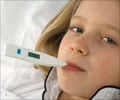The symptoms of seasonal allergic rhinitis (hay fever) in children are decreased by cellulose powder without any adverse effects.

"The cellulose powder has no adverse effects, and this fact makes it a particularly attractive treatment for children. It is used increasingly in many countries, but there is until now no scientific study proving the efficacy of the cellulose powder in children during the pollen season", is the comment from Nils berg, associate professor at the Department of Pediatrics and consultant at the Queen Silvia Children's Hospital.
Therefore, a study was carried out at the Queen Silvia Children's Hospital in Gothenburg during the birch pollen season in spring 2009. The cellulose powder was compared with a placebo (a substance without any medical effect). Fifty-three children and adolescents aged 8-18 years with allergic reaction to pollen participated in the study, lasting for 4 weeks when they puffed the powder in the nose3 times daily. Every day they also were on an antihistamine tablet (the most common treatment of hay fever). Reminders and reporting of symptom scores were performed using SMS messaging on mobile phones.
Pollen occurrence was measured every day on the roof of the hospital, and the pollen counts subsequently were analysed in relation to the symptoms reported by the children. Further data for the study came from previously unpublished statistics of pollen levels collected for 31 years at the same location in Gothenburg, from 1979 to 2009.
"We showed that the nasal symptoms of the children were significantly reduced in those who used the cellulose powder. The best effect was obtained at low to moderate concentrations of pollen, corresponding to the predominating levels in the area during the 31-year period. Furthermore, no adverse effects of the cellulose powder were seen", Nils berg remarks. He concludes:
"The complete absence of adverse effects makes this treatment admirably suited to self-care, and particularly for the treatment of children. Controlled scientific studies such as the present also provide the healthcare system a basis for testing this product as a supplement to other treatments. It is often necessary to combine different agents, at least for parts of the pollen season."
Advertisement















